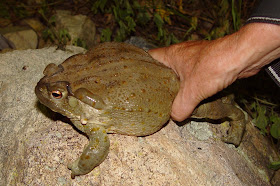In Peppersauce Canyon in the Santa Catalinas Bruce Taubert and I cornered a beautiful Western Lyre Snake Trimorphodon biscutatus. It had vertical pupils and slightly triangular shaped head. With a vibrating tail and a hiss that sounded very much like a rattle the snake did somewhat of a rattler imitation. It's not a total bluff: its grooved hind teeth are used to envenomate prey that in addition is subdued by the coils of the muscular body of the snake.
In Box Canyon, Santa Rita Mountains, the next vertebrate, Equus africanus asinus, took the initiative and investigated us: he marched around the car, rubbing his behind against bumpers and mirrors and shoving his head into every open window. My straw hat was mistaken for a treat and I had to pry it from the burro's teeth.
 |
| Photo by Robyn Waayers |
The best times to see them is in June, when clutches of quail eggs provide enough provision to fatten up the Gila's tail, which seems to be his main energy storage. A second wave of observation reports usually coincides with the monsoon in August when female Gila Monsters lay their clutches of up to 12 eggs (but only every other year).
Our monster was obviously annoyed and hissed at us from his gaping black mouth. Gila Monsters are venomous, but they are hardly fast enough to grab a human and chew on him to transfer the venom that is secreted by glands in the lower jaw and released along grooves in the teeth.
Later at Florida Canyon we found the biggest and heaviest Sonoran Desert Toad that I've ever seen. I need both hands to lift the heavy guy out of the brush around a light where he was harvesting an abundance of bugs, mostly Oxygrylius ruginasus. I hope that Robyn has a picture of that guy. My hands were full.
 |
| Robyn's photo arrived! And no, the toads are not poisonous on contact, but I wouldn't lick them! |






Wonderful captures of the Gila Monster. Thanks for sharing!
ReplyDeleteGila Monsters , Lyre snakes, Desert Toads and bold burros...you had a busy time . Just the way you like it I am sure. Can't wait to see the toad heavyweight.
ReplyDeleteYour toad sounds awesome! I hope we get to see it ... I'd like to meet him close up, but maybe not your Gila monsters.
ReplyDelete